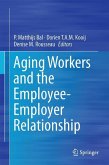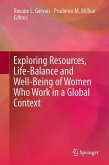Handbook on Well-Being of Working Women
Herausgegeben:Connerley, Mary L.; Wu, Jiyun
Handbook on Well-Being of Working Women
Herausgegeben:Connerley, Mary L.; Wu, Jiyun
- Gebundenes Buch
- Merkliste
- Auf die Merkliste
- Bewerten Bewerten
- Teilen
- Produkt teilen
- Produkterinnerung
- Produkterinnerung
This handbook provides an overview and synthesis of relevant literature related to the issue of the well-being of working women. This focus addresses a gap that currently exists in the quality-of-life and well-being fields. The work of the authors answers the following broad questions: Does gender matter in the well-being of working women? Do prejudices against and stereotypes of women still play a role in inter-personal interactions in the workplace that could hinder women from flourishing professionally? Does the organizational context, such as organizational culture, reward systems, and…mehr
Andere Kunden interessierten sich auch für
![Aging Workers and the Employee-Employer Relationship Aging Workers and the Employee-Employer Relationship]() Aging Workers and the Employee-Employer Relationship104,99 €
Aging Workers and the Employee-Employer Relationship104,99 €![Exploring Resources, Life-Balance and Well-Being of Women Who Work in a Global Context Exploring Resources, Life-Balance and Well-Being of Women Who Work in a Global Context]() Exploring Resources, Life-Balance and Well-Being of Women Who Work in a Global Context75,99 €
Exploring Resources, Life-Balance and Well-Being of Women Who Work in a Global Context75,99 €![The Psychology of Human Leadership The Psychology of Human Leadership]() Michael PaschenThe Psychology of Human Leadership38,99 €
Michael PaschenThe Psychology of Human Leadership38,99 €![Leading Naturally Leading Naturally]() Michael AlznauerLeading Naturally38,99 €
Michael AlznauerLeading Naturally38,99 €![Instrument Development in the Affective Domain Instrument Development in the Affective Domain]() D. Betsy McCoachInstrument Development in the Affective Domain134,99 €
D. Betsy McCoachInstrument Development in the Affective Domain134,99 €![Practitioner's Guide to Legal Issues in Organizations Practitioner's Guide to Legal Issues in Organizations]() Practitioner's Guide to Legal Issues in Organizations75,99 €
Practitioner's Guide to Legal Issues in Organizations75,99 €![Conflict Management Conflict Management]() Stephan ProkschConflict Management49,99 €
Stephan ProkschConflict Management49,99 €-
-
-
This handbook provides an overview and synthesis of relevant literature related to the issue of the well-being of working women. This focus addresses a gap that currently exists in the quality-of-life and well-being fields. The work of the authors answers the following broad questions: Does gender matter in the well-being of working women? Do prejudices against and stereotypes of women still play a role in inter-personal interactions in the workplace that could hinder women from flourishing professionally? Does the organizational context, such as organizational culture, reward systems, and leadership, contribute to the well-being of working-women? What impact does the national context have on the well-being of working women? And finally, how can public policies help enhance the well-being of working women? These are important issues for academics, researchers, and graduate students interested in gender issues in the fields of management, sociology, psychology, social psychology, economics, and quality of life studies. Policy makers and practitioners will also find this book beneficial. Equitable treatment and outcomes for all, regardless of gender, remains a challenging goal to achieve, with various barriers in different contexts and different cultures, and this book provides strong coverage of this important topic of well-being of working women.
Produktdetails
- Produktdetails
- International Handbooks of Quality-of-Life
- Verlag: Springer / Springer Netherlands
- Artikelnr. des Verlages: 978-94-017-9896-9
- 1st ed. 2015
- Seitenzahl: 832
- Erscheinungstermin: 7. August 2015
- Englisch
- Abmessung: 260mm x 183mm x 50mm
- Gewicht: 1660g
- ISBN-13: 9789401798969
- ISBN-10: 9401798966
- Artikelnr.: 42319815
- Herstellerkennzeichnung Die Herstellerinformationen sind derzeit nicht verfügbar.
- International Handbooks of Quality-of-Life
- Verlag: Springer / Springer Netherlands
- Artikelnr. des Verlages: 978-94-017-9896-9
- 1st ed. 2015
- Seitenzahl: 832
- Erscheinungstermin: 7. August 2015
- Englisch
- Abmessung: 260mm x 183mm x 50mm
- Gewicht: 1660g
- ISBN-13: 9789401798969
- ISBN-10: 9401798966
- Artikelnr.: 42319815
- Herstellerkennzeichnung Die Herstellerinformationen sind derzeit nicht verfügbar.
Mary L. Connerley is professor and head of the management department at the University of Northern Iowa. Connerley received her PhD in human resource management from the University of Iowa. Before joining UNI, Connerley was the founding Director of the Business Diversity Center in the Pamplin College of Business at Virginia Tech. Prior to receiving her Ph.D., Dr. Connerley worked for five years with the Executive Development Program at the University of Iowa and has been involved with developing and facilitating Leadership Development Programs ever since. Her most recent programs have focused on Issues of Diversity and Multiculturalism, Managing the Hispanic Workforce, Leading a Multi-Generational Workforce, and Emotional Intelligence in the Workplace. In addition to over 20 articles on human resource and diversity-related issues, she is co-author of the book titled, "Leading in a Diverse and Multicultural Environment: Developing Awareness, Knowledge, and Skills." Her current research and teaching interests center on diversity in the workplace and higher education. Jiyun Wu is an assistant professor in Management and Marketing Department at Rhode Island College. She received her Ph.D. in social issues in management from Virginia Polytechnic Institute and State University (Virginia Tech). Her research areas include quality of work life, subjective well-being, gender and diversity issues, and business ethics. Her works have appeared in Journal of Happiness Studies, Applied Research in Quality of Life, and Business and Society, among others.
Part 1. Introduction.- Chapter. 1 Uncovering the Complexities of Women and Well-Being in the Workplace: An Introduction; Mary L. Connerley and Jiyun Wu.- Part 2. Gender, social group hierarchy, and Well-Being of Working Women.- Chapter 2. Workplace Discrimination and the Wellbeing of Minority Women: Overview, Prospects, and Implications; Gwendolyn M. Combs and Ivana Milosevic.- Chapter. 3 Fat Women Need Not Apply: Employment Weight Discrimination Against Women; Lynn K. Bartels.- Chapter. 4 Countering Heteronormativity; Lesbians and Well-Being in the Workplace; Helen Woodruffe-Burton.- Chapter 5. "Women Like You Keep Women Like Me Down": Understanding Intergenerational Conflict and Work-life Balance from a Discourse Perspective; Renee Guarriello Heath.- Chapter 6. Sexual Harassment: Undermining the Wellbeing of Working Women; Kathryn J. Holland and Lilia M. Cortina.- Chapter 7. Understanding Mental Disorders in Women in the Workplace to Mitigate Deleterious Effects; Wesley S. Parks, Paula K. Lundberg-Love, Cecily Luft, Aimee Stewart and Haley Peddy.- Chapter 8. Women and Work Stress: More and Different; Astrid Richardsen, Laura E. M. Traavik and Ronald J. Burke.- Chapter 9. The Gender Pay Gap and the Wellbeing of Working Women; Hilary M. Lips.- Part 3. Women Leaders and Well-Being.- Chapter 10. Gender Bias Against Female Leaders: A Review; Kim M. Elsesser.- Chapter 11. Does the Presence of Women in Management Impact Gender Inequality?; Matt L. Huffman.- Chapter 12. In the Company of Women: The Well-Being Consequences of Working With (and for) Other Women; Carol T. Kulik, Isabel Metz and Jill A. Gould.- Chapter 13 Constrained by Emotion: Women, Leadership, and Expressing Emotion in the Workplace. Jacqueline S. Smith, Victoria L. Brescoll, and Erin L. Thomas.- Chapter 14. The Purpose and Place of Mentoring for Women Managers in Organisations: An Australian Perspective; Lisa Catherine Ehrich and Megan Kimber.- Chapter 15. French Women Entrepreneurs'Leadership Practices and Well-Being in a High Growth Context; Stephanie Chasserio, Corinne Poroli and Renaud Redien-Collot.- Part 4. Professional Context and the Well-Being of Working Women.- Chapter 16. Women in Medicine; Tracey LaPierre, Shirley Hill and Emily Jones.- Chapter 17. The Relationship between Organizational Family Support and Burnout among Working Women at Healthcare Industry: Core Self-Evaluation as Moderator; Peng Wang, Teresa A. Wagner, Scott L. Boyar, Steven A. Corman and Ronald B. McKinley.- Chapter 18. Still Alone at the Table? Women Working in Technology Organizations; Marilyn Drury.- Chapter 19. Women Accountants in Practicing Accounting Firms: Their Status, Investments and Returns; Simeon O. Okpechi and Rachid Belmasrour.- Chapter 20. Work-Family Balance for Women Lawyers Today: A Reality or Still a Dream?; Diane-Gabrielle Tremblay.- Chapter 21. Knowledge Work and Flexible Working: Helping or Hindering Working Women?; Doris Ruth Eikhof.- Chapter 22. Gender, Entrepreneurship, and Firm Performance: Recent Research and Considerations of Context; Susan Coleman.- Chapter 23. Extreme Expatriation: The Effect of Location Factors and Masculine Environments on Women's International Assignment Participation in Oil and Gas Exploration and Production; Susan Shortland.- Part 5. Public Policy, Organizational Policy and Societal Influences and The Well-Being of Working Women.- Chapter 24. Work-Life Policies, Programs, and Practices: Helping Women, Men, and Workplaces; Laura Sabattini and Faye J. Crosby.- Chapter 25. The Gender-Career Estimation Gap; Lutz C. Kaiser.- Chapter 26. Family and Labor Market Policies in Germany: The Well-being of Working Women; Jessica K. Camp, Eileen Trzcinski and Stella Resko.- Chapter 27. Social Costs: The Career-Family Tradeoff; Bridgette Cram, Mohamad G. Alkadry and Leslie E. Tower.- Chapter 28. An Exploration of Quality Part-Time Working in Europe, with a Focus on the UK Case; Clare Lyonette, Beate Baldauf and HeikeBehle.- Chapter 29. Opting in: Women in Search of Well-Being; Ingrid Biese and Linda McKie.- Chapter 30. The Well-Being of Working Women in Times of Economic Crisis and Recovery: Insights from the Great Recession; Janice Peterson.- Chapter 31. Let Us Listen to the Voice of Women in Management in Spain in the 21st Century: A Longitudinal Study; Rosario Vázquez Carrasco, Ma. Eugenia López Pérez and Edgar Centeno.- Chapter 32. Women in the Workplace: Feminism's Potential Impact; Kendra Saunders.- Part 6. Cross-cultural and country-specific context and the Well-Being of Working Women: A Global Perspective.- Chapter 33. Women in the Workforce: A Global Snapshot; Betty Jane Punnett.- Chapter 34. Are Education and Occupational Status Affecting Men's and Women's Satisfaction in Different Ways? A Cross-National Perspective on Gender Inequality; Mª del Mar Salinas-Jimenez, Joaquín Artes and Javier Salinas-Jimenez.- Chapter 35. The Subjective Well-Being of Working Women in Europe; Eduardo Bericat.- Chapter 36. Inequalities in Unpaid Work: A Cross-National Comparison; Janeen Baxter and Tsui-o Tai.- Chapter 37. Work Satisfaction of Chinese Women; Hang Ye Ngo and Huimin Liu.- Chapter 38. Working Women in Arab Countries: A Case for Cautious Optimism; Yusuf M. Sidani.- Chapter 39. Work-Family Balance and the Well-being of Educated Women in Iran; Narjes Mehdizadeh.- Chapter 40. Work, Family and Women's Well-Being in Malaysia; Noraini M. Noor and Nor Diana Mohd Mahudin.- Chapter 41. The Reality of Women on the Boards of Directors of Brazilian Companies: Seeking Insight and Solutions; Kellen Lazzaretti and Christiane Kleinübing Godoi.- Chapter 42. Gendered Ideology, Male Dominance and Women's Microcredit Participation in Rural Bangladesh; K. M. Rabiul Karim and Chi Kong Law.- Chapter 43. Employment, Empowerment, and Spousal Violence on Women in Developing Countries; Yoo-Mi Chin.- Chapter 44. Impact of HIV Related Stigma and Discrimination on Working Womenin Sub-Sahara Africa; Vincent Icheku.- Part 7. Epilogue.- Chapter 45. Feminist Eudaemonia: A Research Direction; Jiyun Wu and Mary L. Connerley.
Part 1. Introduction.- Chapter. 1 Uncovering the Complexities of Women and Well-Being in the Workplace: An Introduction; Mary L. Connerley and Jiyun Wu.- Part 2. Gender, social group hierarchy, and Well-Being of Working Women.- Chapter 2. Workplace Discrimination and the Wellbeing of Minority Women: Overview, Prospects, and Implications; Gwendolyn M. Combs and Ivana Milosevic.- Chapter. 3 Fat Women Need Not Apply: Employment Weight Discrimination Against Women; Lynn K. Bartels.- Chapter. 4 Countering Heteronormativity; Lesbians and Well-Being in the Workplace; Helen Woodruffe-Burton.- Chapter 5. "Women Like You Keep Women Like Me Down": Understanding Intergenerational Conflict and Work-life Balance from a Discourse Perspective; Renee Guarriello Heath.- Chapter 6. Sexual Harassment: Undermining the Wellbeing of Working Women; Kathryn J. Holland and Lilia M. Cortina.- Chapter 7. Understanding Mental Disorders in Women in the Workplace to Mitigate Deleterious Effects; Wesley S. Parks, Paula K. Lundberg-Love, Cecily Luft, Aimee Stewart and Haley Peddy.- Chapter 8. Women and Work Stress: More and Different; Astrid Richardsen, Laura E. M. Traavik and Ronald J. Burke.- Chapter 9. The Gender Pay Gap and the Wellbeing of Working Women; Hilary M. Lips.- Part 3. Women Leaders and Well-Being.- Chapter 10. Gender Bias Against Female Leaders: A Review; Kim M. Elsesser.- Chapter 11. Does the Presence of Women in Management Impact Gender Inequality?; Matt L. Huffman.- Chapter 12. In the Company of Women: The Well-Being Consequences of Working With (and for) Other Women; Carol T. Kulik, Isabel Metz and Jill A. Gould.- Chapter 13 Constrained by Emotion: Women, Leadership, and Expressing Emotion in the Workplace. Jacqueline S. Smith, Victoria L. Brescoll, and Erin L. Thomas.- Chapter 14. The Purpose and Place of Mentoring for Women Managers in Organisations: An Australian Perspective; Lisa Catherine Ehrich and Megan Kimber.- Chapter 15. French Women Entrepreneurs'Leadership Practices and Well-Being in a High Growth Context; Stephanie Chasserio, Corinne Poroli and Renaud Redien-Collot.- Part 4. Professional Context and the Well-Being of Working Women.- Chapter 16. Women in Medicine; Tracey LaPierre, Shirley Hill and Emily Jones.- Chapter 17. The Relationship between Organizational Family Support and Burnout among Working Women at Healthcare Industry: Core Self-Evaluation as Moderator; Peng Wang, Teresa A. Wagner, Scott L. Boyar, Steven A. Corman and Ronald B. McKinley.- Chapter 18. Still Alone at the Table? Women Working in Technology Organizations; Marilyn Drury.- Chapter 19. Women Accountants in Practicing Accounting Firms: Their Status, Investments and Returns; Simeon O. Okpechi and Rachid Belmasrour.- Chapter 20. Work-Family Balance for Women Lawyers Today: A Reality or Still a Dream?; Diane-Gabrielle Tremblay.- Chapter 21. Knowledge Work and Flexible Working: Helping or Hindering Working Women?; Doris Ruth Eikhof.- Chapter 22. Gender, Entrepreneurship, and Firm Performance: Recent Research and Considerations of Context; Susan Coleman.- Chapter 23. Extreme Expatriation: The Effect of Location Factors and Masculine Environments on Women's International Assignment Participation in Oil and Gas Exploration and Production; Susan Shortland.- Part 5. Public Policy, Organizational Policy and Societal Influences and The Well-Being of Working Women.- Chapter 24. Work-Life Policies, Programs, and Practices: Helping Women, Men, and Workplaces; Laura Sabattini and Faye J. Crosby.- Chapter 25. The Gender-Career Estimation Gap; Lutz C. Kaiser.- Chapter 26. Family and Labor Market Policies in Germany: The Well-being of Working Women; Jessica K. Camp, Eileen Trzcinski and Stella Resko.- Chapter 27. Social Costs: The Career-Family Tradeoff; Bridgette Cram, Mohamad G. Alkadry and Leslie E. Tower.- Chapter 28. An Exploration of Quality Part-Time Working in Europe, with a Focus on the UK Case; Clare Lyonette, Beate Baldauf and HeikeBehle.- Chapter 29. Opting in: Women in Search of Well-Being; Ingrid Biese and Linda McKie.- Chapter 30. The Well-Being of Working Women in Times of Economic Crisis and Recovery: Insights from the Great Recession; Janice Peterson.- Chapter 31. Let Us Listen to the Voice of Women in Management in Spain in the 21st Century: A Longitudinal Study; Rosario Vázquez Carrasco, Ma. Eugenia López Pérez and Edgar Centeno.- Chapter 32. Women in the Workplace: Feminism's Potential Impact; Kendra Saunders.- Part 6. Cross-cultural and country-specific context and the Well-Being of Working Women: A Global Perspective.- Chapter 33. Women in the Workforce: A Global Snapshot; Betty Jane Punnett.- Chapter 34. Are Education and Occupational Status Affecting Men's and Women's Satisfaction in Different Ways? A Cross-National Perspective on Gender Inequality; Mª del Mar Salinas-Jimenez, Joaquín Artes and Javier Salinas-Jimenez.- Chapter 35. The Subjective Well-Being of Working Women in Europe; Eduardo Bericat.- Chapter 36. Inequalities in Unpaid Work: A Cross-National Comparison; Janeen Baxter and Tsui-o Tai.- Chapter 37. Work Satisfaction of Chinese Women; Hang Ye Ngo and Huimin Liu.- Chapter 38. Working Women in Arab Countries: A Case for Cautious Optimism; Yusuf M. Sidani.- Chapter 39. Work-Family Balance and the Well-being of Educated Women in Iran; Narjes Mehdizadeh.- Chapter 40. Work, Family and Women's Well-Being in Malaysia; Noraini M. Noor and Nor Diana Mohd Mahudin.- Chapter 41. The Reality of Women on the Boards of Directors of Brazilian Companies: Seeking Insight and Solutions; Kellen Lazzaretti and Christiane Kleinübing Godoi.- Chapter 42. Gendered Ideology, Male Dominance and Women's Microcredit Participation in Rural Bangladesh; K. M. Rabiul Karim and Chi Kong Law.- Chapter 43. Employment, Empowerment, and Spousal Violence on Women in Developing Countries; Yoo-Mi Chin.- Chapter 44. Impact of HIV Related Stigma and Discrimination on Working Womenin Sub-Sahara Africa; Vincent Icheku.- Part 7. Epilogue.- Chapter 45. Feminist Eudaemonia: A Research Direction; Jiyun Wu and Mary L. Connerley.








